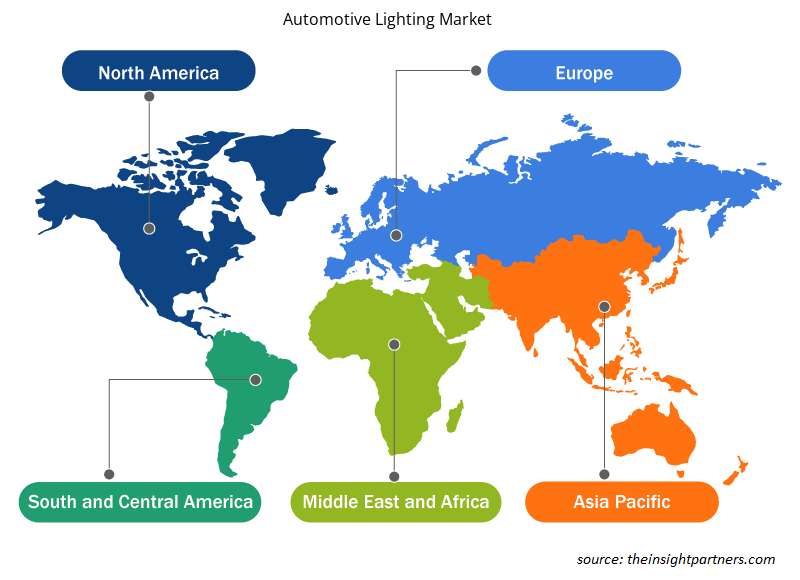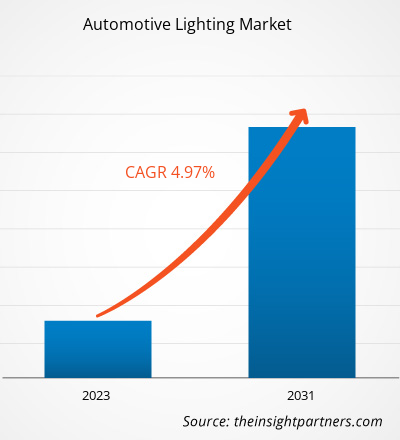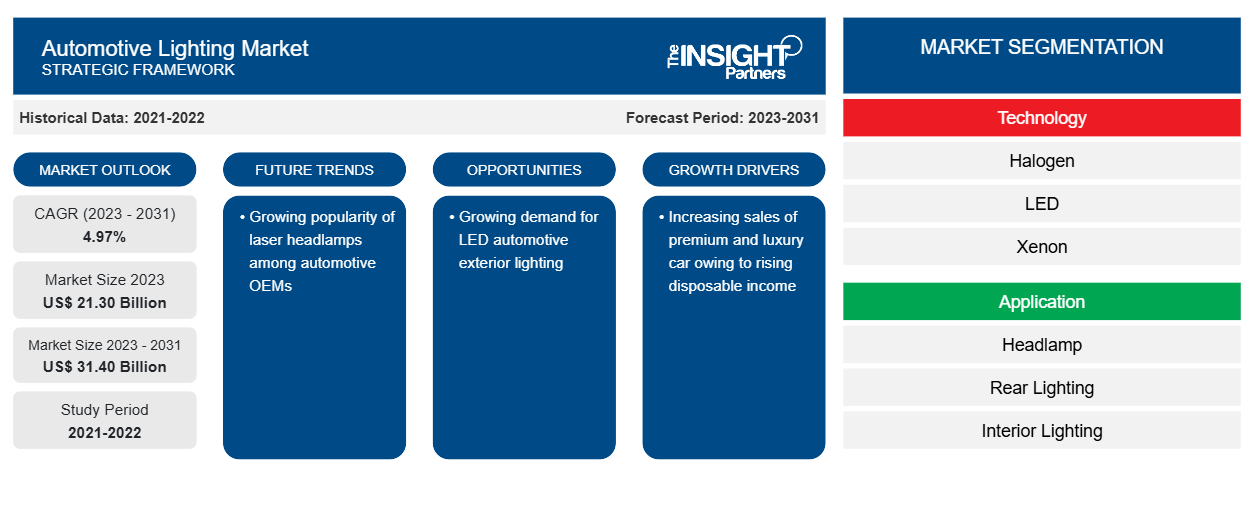Der Markt für Autobeleuchtung soll von 21,30 Milliarden US-Dollar im Jahr 2023 auf 31,40 Milliarden US-Dollar im Jahr 2031 anwachsen. Der Markt soll zwischen 2023 und 2031 eine durchschnittliche jährliche Wachstumsrate von 4,97 % verzeichnen. Der Anstieg der Verkäufe von Premium- und Luxusautos treibt den Markt für Autobeleuchtung an und bietet auch den Beleuchtungslieferanten Wachstumsaussichten.
Marktanalyse für Automobilbeleuchtung
Das Ökosystem der Autobeleuchtung besteht aus den folgenden wichtigen Interessengruppen: Rohstofflieferanten, Autobeleuchtungshersteller/OEMs und Endverbraucher. Zu den Rohstofflieferanten zählen Anbieter, die wichtige Rohstoffkomponenten für die Autobeleuchtung bereitstellen, wie unter anderem Kupfer , Aluminium, LEDs und Laserdioden. Autobeleuchtungshersteller/OES wie unter anderem Osram-Continental, Lumileds, Hella, Valeo und Automotive-Lighting integrieren und entwickeln Autobeleuchtung für verschiedene Fahrzeugtypen. Automobil-OEMs geben die fahrzeugspezifischen Scheinwerfer, Rücklichter und Signalleuchten oder Baupläne an die Anbieter weiter. Die Anbieter legen individuelle Angebote vor, um um den Zuschlag des Lieferanten zu bitten. Der ausgewählte Anbieter liefert dann während der Laufzeit der Ausschreibung die fahrzeugspezifischen Beleuchtungssysteme. Die OEMs integrieren diese Beleuchtungskomponenten in ihr endgültiges Fahrzeug.
Marktübersicht für Automobilbeleuchtung
Derzeit dominieren LED-Matrix-Beleuchtungslösungen die gesamte Fahrzeugbeleuchtung. Die Matrix-Lasertechnologie soll durch ihre hochauflösenden Eigenschaften die Straßenbeleuchtung weiter verbessern. Die Matrix-Lasertechnologie basiert auf dem LaserSpot für Fernlichtlampen. Mit der Matrix-Lasertechnologie ist es möglich geworden, die Projektortechnologie in den Scheinwerfern der Personenkraftwagen zu bündeln. Der Leuchtdichtefaktor der Laser ist etwa fünfmal höher als bei anderen auf dem Markt erhältlichen Lichtquellen, und daher bieten die Laserscheinwerfer den Fahrzeugführern größere Leuchtweiten. Die Leuchtweite eines typischen Laserscheinwerfers beträgt über 500 m. Der BMW i8 und der BMW 7 sind die anderen Pkw-Serien, die mit laserintegrierten Scheinwerfern ausgestattet sind.
Passen Sie diesen Bericht Ihren Anforderungen an
Sie erhalten kostenlos individuelle Anpassungen an jedem Bericht, einschließlich Teilen dieses Berichts oder einer Analyse auf Länderebene, eines Excel-Datenpakets sowie tolle Angebote und Rabatte für Start-ups und Universitäten.
-
Holen Sie sich die wichtigsten Markttrends aus diesem Bericht.Dieses KOSTENLOSE Beispiel umfasst eine Datenanalyse von Markttrends bis hin zu Schätzungen und Prognosen.
Treiber und Chancen auf dem Automobilbeleuchtungsmarkt
Steigende Verkäufe von Premium- und Luxusautos aufgrund steigender verfügbarer Einkommen
In den Industrieländern, in denen die Verbraucher über ein riesiges verfügbares Einkommen verfügen, hat man beobachtet, dass sich mit der Zunahme der Fahrzeugpopulation die Verbraucherpräferenzen beim Kauf von Personenkraftwagen ändern. Infolgedessen sind Kosten und Kraftstoffeffizienz nicht mehr die Hauptkriterien für den Kauf dieser Autos; stattdessen hängt der Kauf eher vom Komfort und Luxus ab, den sie bieten. Darüber hinaus berücksichtigen Verbraucher bei der Auswahl zunehmend Beleuchtungssysteme und Fahrzeugergonomie.
Steigende Nachfrage nach LED-Außenbeleuchtung für Autos
Laut Angaben der National Highway Traffic Safety Administration (NHTSA) ereignen sich etwa 50 % aller tödlichen Unfälle mit Personenkraftwagen im Dunkeln, obwohl nur 25 % der gesamten Fahrzeit von Personenkraftwagen nachts verbracht werden. Dies ist hauptsächlich auf die unzureichende Sicht und Beleuchtung der Straßen sowie die unzureichende Beleuchtung durch die Scheinwerfer der Fahrzeuge zurückzuführen. Sicherheitsbedenken haben die Automobilhersteller dazu veranlasst, nach einer sichereren Alternative zu suchen. Die LEDriving-Nebelscheinwerfer von OSRAM sind in Bezug auf Innovation, Design und Leistung bemerkenswert. Darüber hinaus bietet Philips die Technologien AirFlux und AirCool an, mit denen die von LED-Nebelscheinwerfern erzeugte Wärme kontrolliert werden kann. Dabei handelt es sich um intelligente Kühlsysteme, die die Wärme von den kritischen Komponenten des Lichts ableiten, wodurch die Hitzebeständigkeit erhöht und die Lebensdauer der LEDs effektiv verlängert wird.
Segmentierungsanalyse des Marktberichts zur Automobilbeleuchtung
Wichtige Segmente, die zur Ableitung der Marktanalyse für Fahrzeugbeleuchtung beigetragen haben, sind Technologie, Anwendung und Fahrzeugtyp.
- Basierend auf der Technologie wurde der Markt für Fahrzeugbeleuchtung in Halogen, LED, Xenon und Laser unterteilt. Das LED-Segment hatte im Jahr 2023 einen größeren Marktanteil.
- Basierend auf der Anwendung ist der Markt für Automobilbeleuchtung in Scheinwerfer, Rückbeleuchtung, Innenbeleuchtung, CHMSL, Nebelscheinwerfer und kleine Lampen unterteilt. Das Scheinwerfersegment hatte im Jahr 2023 den größten Marktanteil.
- Basierend auf dem Fahrzeugtyp wurde der Markt für Fahrzeugbeleuchtung in Pkw, LCV sowie MCV & HCV unterteilt. Das Pkw-Segment hatte im Jahr 2023 einen größeren Marktanteil.
Automobilbeleuchtung Marktanalyse nach Geografie
Der geografische Umfang des Marktberichts zur Fahrzeugbeleuchtung ist hauptsächlich in fünf Regionen unterteilt: Nordamerika, Europa, Asien-Pazifik, Naher Osten und Afrika sowie Südamerika.
Der Umfang des Marktberichts für Fahrzeugbeleuchtung umfasst Nordamerika (USA, Kanada und Mexiko), Europa (Spanien, Großbritannien, Deutschland, Frankreich, Italien und den Rest Europas), den asiatisch-pazifischen Raum (Südkorea, China, Indien, Japan, Australien und den Rest des asiatisch-pazifischen Raums), den Nahen Osten und Afrika (Südafrika, Saudi-Arabien, die Vereinigten Arabischen Emirate und den Rest des Nahen Ostens und Afrikas) sowie Süd- und Mittelamerika (Brasilien, Argentinien und den Rest Süd- und Mittelamerikas). In Bezug auf den Umsatz dominierte der asiatisch-pazifische Raum im Jahr 2023 den Marktanteil im Bereich Fahrzeugbeleuchtung. Europa ist der zweitgrößte Beitragszahler zum globalen Markt für Fahrzeugbeleuchtung, gefolgt von Nordamerika.
Regionale Einblicke in den Markt für Autobeleuchtung
Die regionalen Trends und Faktoren, die den Markt für Fahrzeugbeleuchtung im Prognosezeitraum beeinflussen, wurden von den Analysten von Insight Partners ausführlich erläutert. In diesem Abschnitt werden auch die Marktsegmente und die Geografie für Fahrzeugbeleuchtung in Nordamerika, Europa, im asiatisch-pazifischen Raum, im Nahen Osten und Afrika sowie in Süd- und Mittelamerika erörtert.

- Erhalten Sie regionale Daten zum Markt für Fahrzeugbeleuchtung
Umfang des Marktberichts zur Fahrzeugbeleuchtung
| Berichtsattribut | Details |
|---|---|
| Marktgröße im Jahr 2023 | 21,30 Milliarden US-Dollar |
| Marktgröße bis 2031 | 31,40 Milliarden US-Dollar |
| Globale CAGR (2023 - 2031) | 4,97 % |
| Historische Daten | 2021-2022 |
| Prognosezeitraum | 2023–2031 |
| Abgedeckte Segmente |
Nach Technologie
|
| Abgedeckte Regionen und Länder |
Nordamerika
|
| Marktführer und wichtige Unternehmensprofile |
|
Dichte der Marktteilnehmer für Fahrzeugbeleuchtung: Auswirkungen auf die Geschäftsdynamik verstehen
Der Markt für Autobeleuchtung wächst rasant, angetrieben durch die steigende Nachfrage der Endnutzer aufgrund von Faktoren wie sich entwickelnden Verbraucherpräferenzen, technologischen Fortschritten und einem größeren Bewusstsein für die Vorteile des Produkts. Mit steigender Nachfrage erweitern Unternehmen ihr Angebot, entwickeln Innovationen, um die Bedürfnisse der Verbraucher zu erfüllen, und nutzen neue Trends, was das Marktwachstum weiter ankurbelt.
Die Marktteilnehmerdichte bezieht sich auf die Verteilung von Firmen oder Unternehmen, die in einem bestimmten Markt oder einer bestimmten Branche tätig sind. Sie gibt an, wie viele Wettbewerber (Marktteilnehmer) in einem bestimmten Marktraum im Verhältnis zu seiner Größe oder seinem gesamten Marktwert präsent sind.
Die wichtigsten auf dem Markt für Fahrzeugbeleuchtung tätigen Unternehmen sind:
- Autobeleuchtung GmbH
- Hella GmbH & Co. KGaA
- Koito Manufacturing Co.
- GmbH.
- Lumileds Holding BV
Haftungsausschluss : Die oben aufgeführten Unternehmen sind nicht in einer bestimmten Reihenfolge aufgeführt.

- Überblick über die wichtigsten Akteure auf dem Markt für Fahrzeugbeleuchtung
Neuigkeiten und aktuelle Entwicklungen zum Markt für Fahrzeugbeleuchtung
Der Markt für Fahrzeugbeleuchtung wird durch die Erhebung qualitativer und quantitativer Daten nach Primär- und Sekundärforschung bewertet, die wichtige Unternehmensveröffentlichungen, Verbandsdaten und Datenbanken umfasst. Im Folgenden finden Sie eine Liste der Entwicklungen auf dem Markt für Fahrzeugbeleuchtung und der Strategien:
- Im Juli 2023 bringt Marelli gemeinsam mit ams OSRAM eine bahnbrechende Innovation im Bereich der Frontbeleuchtung von Autos auf den Markt und stellt das h-Digi® microLED-Modul vor, das nun in Serie produziert wird. Diese digitale Lichtlösung, die auf einem neuen Typ intelligenter Multipixel-LED basiert, ermöglicht eine vollständig adaptive, dynamische Scheinwerfersteuerung und Bildprojektion und ist gleichzeitig eine erschwingliche Technologie, die für eine größere Bandbreite an Fahrzeugen verfügbar ist. (Quelle: Marelli, Pressemitteilung/Unternehmenswebsite/Newsletter)
- Im Dezember 2023 kündigte OLEDWorks an, dass es auf der CES 2024 die neueste OLED-Beleuchtungstechnologie für die Automobilindustrie präsentieren und die Landschaft mit der Einführung einer aufregenden neuen Marke neu definieren wird. Das OLEDWorks-Team, bestehend aus technischen OLED-Experten und Kundenlösungsstrategen, freut sich darauf, die Besucher am Stand Nr. 3225 in der West Hall des Las Vegas Convention Center begrüßen zu dürfen, wo sie die neuesten Innovationen erleben können, die die Zukunft der Automobilbeleuchtung prägen werden. (Quelle: OLEDWorks, Pressemitteilung/Unternehmenswebsite/Newsletter)
Marktbericht zur Fahrzeugbeleuchtung – Abdeckung und Ergebnisse
Der Bericht „Marktgröße und Prognose für Automobilbeleuchtung (2021–2031)“ bietet eine detaillierte Analyse des Marktes, die die folgenden Bereiche abdeckt:
- Marktgröße und Prognose auf globaler, regionaler und Länderebene für alle wichtigen Marktsegmente, die im Rahmen des Projekts abgedeckt sind
- Marktdynamik wie Treiber, Beschränkungen und wichtige Chancen
- Wichtige Zukunftstrends
- Detaillierte Porter's Five Forces Analyse
- Globale und regionale Marktanalyse mit wichtigen Markttrends, wichtigen Akteuren, Vorschriften und aktuellen Marktentwicklungen
- Branchenlandschaft und Wettbewerbsanalyse, einschließlich Marktkonzentration, Heatmap-Analyse, prominenten Akteuren und aktuellen Entwicklungen
- Detaillierte Firmenprofile mit SWOT-Analyse
- Historische Analyse (2 Jahre), Basisjahr, Prognose (7 Jahre) mit CAGR
- PEST- und SWOT-Analyse
- Marktgröße Wert/Volumen – Global, Regional, Land
- Branchen- und Wettbewerbslandschaft
- Excel-Datensatz
Aktuelle Berichte
Erfahrungsberichte
Grund zum Kauf
- Fundierte Entscheidungsfindung
- Marktdynamik verstehen
- Wettbewerbsanalyse
- Kundeneinblicke
- Marktprognosen
- Risikominimierung
- Strategische Planung
- Investitionsbegründung
- Identifizierung neuer Märkte
- Verbesserung von Marketingstrategien
- Steigerung der Betriebseffizienz
- Anpassung an regulatorische Trends























 Kostenlose Probe anfordern für - Markt für Automobilbeleuchtung
Kostenlose Probe anfordern für - Markt für Automobilbeleuchtung